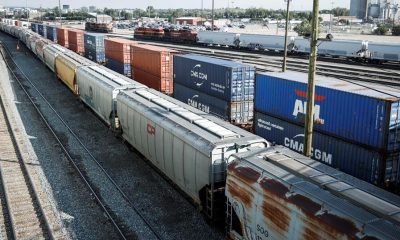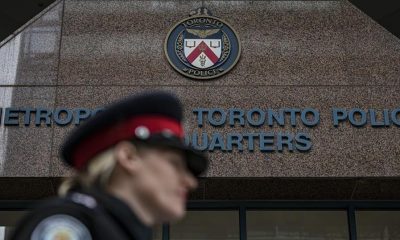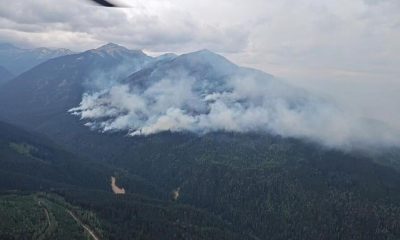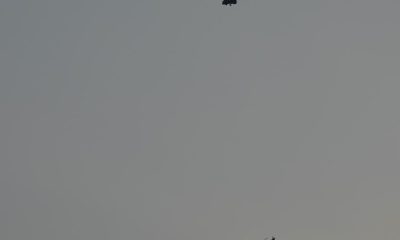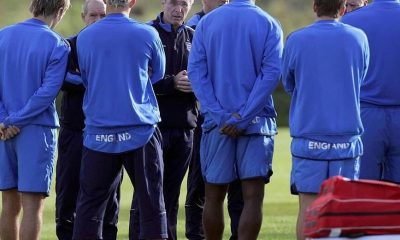Science
Russian space officials try to blame NASA astronaut for Soyuz air leak in 2018: report – Space.com
CAPE CANAVERAL, Fla. — NASA’s head of human spaceflight says the agency stands behind its astronauts following claims that a U.S. crewmember at the International Space Station sabotaged a Russian Soyuz spacecraft in 2018, causing an air leak at the orbiting laboratory.
On Friday afternoon (Aug. 13), during a media teleconference about recent delays with Boeing’s Starliner spacecraft, NASA’s human spaceflight chief Kathy Lueders told reporters that the personal attacks against NASA astronaut and Expedition 56 flight engineer Serena Auñón-Chancellor were baseless.
“Serena is an extremely well-respected crew member who has served her country and made invaluable contributions to the agency,” Lueders told reporters. “And I stand behind Serena — we stand behind Serena and her professional conduct and I did not find this accusation credible.”
Related: Space Station commander: It’s ‘absolutely a shame’ to suggest astronauts caused air leak
Lueders expressed those same sentiments on Twitter Friday afternoon, with NASA’s administrator, Senator Bill Nelson agreeing.:
“I wholeheartedly agree with Kathy’s statement,” Nelson tweeted. “I fully support Serena and I will always stand behind our astronauts.”
Russian accusations
NASA leadership’s statements on Friday follow on the heels of accusations from an unnamed “high-ranking” official with Russia’s space agency made in the Russian news agency TASS. The agency claims that in 2018, Auñón-Chancellor had an emotional breakdown in space and then damaged a Russian Soyuz spacecraft that was docked at the station so that she could return to Earth early.
The article, published on Thursday (Aug. 12), responds to criticism from U.S. media in regards to the near-disastrous incident involving Russia’s Nauka science module and the International Space Station (ISS) earlier this month.
Related: Space station situation with Russia’s Nauka module misfire was more serious than stated

In the TASS article, Russian journalist Mikhail Kotov interviews an anonymous official at Russia’s space agency, Roscosmos.
The article is particularly troublesome because it not only names Auñón-Chancellor — the only female astronaut on station at the time — specifically, but it also reveals a medical condition she suffered on-orbit. (Typically NASA keeps all astronaut medical records and conditions private.)
Auñón-Chancellor was treated upon her return to Earth for a deep vein thrombosis, also known as a blood clot, in the jugular vein of her neck. But Kotov implies that dealing with such a condition in space could spur her to want to leave the ISS prematurely, and therefore sabotage the spacecraft that brought her to the orbital outpost in an effort to return home ahead of schedule.
Leaky Soyuz
On Aug. 29, 2018, ISS controllers at NASA’s Johnson Space Center in Houston noticed a slight pressure drop aboard the orbiting outpost. They notified the crew the next day, and the crew was able to trace the leak to a small hole in Russia’s Soyuz MS-09 spacecraft, which had docked to the space station in June with Auñón-Chancellor, European Space Agency astronaut Alexander Gerst and Russian cosmonaut Sergey Prokopyev.
Prokopyev, the commander of the Soyuz at the time, solved the problem by patching the 2-millimeter (0.08 inches) hole using epoxy and gauze. NASA officials stressed that the crew was never in any danger.
Russian space officials decided to investigate the leak, determined to find out its cause. Shortly thereafter, Dmitry Rogozin — the head of Roscosmos — announced that the breach in the Soyuz wall was a drill hole. And according to Rogozin, the person who made the hole apparently had “a faltering hand,” citing nearby scuff marks that likely resulted when the drill slipped.
Russian officials went one step further insinuating that the unsteady hand was likely due to the culprit drilling in microgravity, meaning one of the crew was to blame — not the Russian engineers involved in the assembly and testing of the Soyuz spacecraft before launch down on Earth.

NASA officials knew the precise locations of the U.S. astronauts before the leak occurred and at the moment it began, thanks to space station surveillance. The video footage indicated that none of the U.S. astronauts on the station were near the Russian segment where the Soyuz vehicle was docked. But the Russians didn’t buy it. They were convinced that one of the crew sabotaged the Soyuz.
The recent TASS article takes those claims one step further and insists that NASA video of the ISS could have been tampered with and that Russian officials were denied the chance to examine Russian tools and administer polygraphs, or lie detector tests, to the astronauts.
But the TASS article seems to dismiss the most likely cause of the hole: human error on the ground. The problem most likely happened on Earth, before launch. This was something that Roscosmos was looking into but the agency has never definitively disclosed the results.
Most likely a technician accidentally damaged the Soyuz spacecraft and then tried to cover up the error with a makeshift patch. That patch could have then become dislodged during flight or its time on-orbit after repeated exposure to extreme temperature differences as the station orbits the Earth.
Looking ahead
Related stories
Relations between the two space agencies have grown more strained over recent years, but NASA leadership is hopeful for a continued orbital partnership.
Prior to the launch attempt of Boeing’s Starliner spacecraft on July 30, Nelson told Space.com that he applauded the long-standing relationship between the two agencies. “Terrestrially, we have enormous tensions with Russia, but in space we have cooperation.”
Nelson also said that he expects Russia will continue to work with NASA to maintain the ISS and that he hopes to announce sometime soon that a cosmonaut will fly on an upcoming SpaceX Crew Dragon flight, something the agency has been trying to arrange for quite some time.
Perhaps cosmonauts will make their U.S. commercial spaceflight debut with the SpaceX Crew-4 mission, currently slated to launch in2022, Nelson has said, but nothing is confirmed yet.
Follow Amy Thompson on Twitter @astrogingersnap. Follow us on Twitter @Spacedotcom or Facebook.
Science
Asteroid Apophis will visit Earth in 2029, and this European satellite will be along for the ride

The European Space Agency is fast-tracking a new mission called Ramses, which will fly to near-Earth asteroid 99942 Apophis and join the space rock in 2029 when it comes very close to our planet — closer even than the region where geosynchronous satellites sit.
Ramses is short for Rapid Apophis Mission for Space Safety and, as its name suggests, is the next phase in humanity’s efforts to learn more about near-Earth asteroids (NEOs) and how we might deflect them should one ever be discovered on a collision course with planet Earth.
In order to launch in time to rendezvous with Apophis in February 2029, scientists at the European Space Agency have been given permission to start planning Ramses even before the multinational space agency officially adopts the mission. The sanctioning and appropriation of funding for the Ramses mission will hopefully take place at ESA’s Ministerial Council meeting (involving representatives from each of ESA’s member states) in November of 2025. To arrive at Apophis in February 2029, launch would have to take place in April 2028, the agency says.
This is a big deal because large asteroids don’t come this close to Earth very often. It is thus scientifically precious that, on April 13, 2029, Apophis will pass within 19,794 miles (31,860 kilometers) of Earth. For comparison, geosynchronous orbit is 22,236 miles (35,786 km) above Earth’s surface. Such close fly-bys by asteroids hundreds of meters across (Apophis is about 1,230 feet, or 375 meters, across) only occur on average once every 5,000 to 10,000 years. Miss this one, and we’ve got a long time to wait for the next.
When Apophis was discovered in 2004, it was for a short time the most dangerous asteroid known, being classified as having the potential to impact with Earth possibly in 2029, 2036, or 2068. Should an asteroid of its size strike Earth, it could gouge out a crater several kilometers across and devastate a country with shock waves, flash heating and earth tremors. If it crashed down in the ocean, it could send a towering tsunami to devastate coastlines in multiple countries.
Over time, as our knowledge of Apophis’ orbit became more refined, however, the risk of impact greatly went down. Radar observations of the asteroid in March of 2021 reduced the uncertainty in Apophis’ orbit from hundreds of kilometers to just a few kilometers, finally removing any lingering worries about an impact — at least for the next 100 years. (Beyond 100 years, asteroid orbits can become too unpredictable to plot with any accuracy, but there’s currently no suggestion that an impact will occur after 100 years.) So, Earth is expected to be perfectly safe in 2029 when Apophis comes through. Still, scientists want to see how Apophis responds by coming so close to Earth and entering our planet’s gravitational field.
“There is still so much we have yet to learn about asteroids but, until now, we have had to travel deep into the solar system to study them and perform experiments ourselves to interact with their surface,” said Patrick Michel, who is the Director of Research at CNRS at Observatoire de la Côte d’Azur in Nice, France, in a statement. “Nature is bringing one to us and conducting the experiment itself. All we need to do is watch as Apophis is stretched and squeezed by strong tidal forces that may trigger landslides and other disturbances and reveal new material from beneath the surface.”
By arriving at Apophis before the asteroid’s close encounter with Earth, and sticking with it throughout the flyby and beyond, Ramses will be in prime position to conduct before-and-after surveys to see how Apophis reacts to Earth. By looking for disturbances Earth’s gravitational tidal forces trigger on the asteroid’s surface, Ramses will be able to learn about Apophis’ internal structure, density, porosity and composition, all of which are characteristics that we would need to first understand before considering how best to deflect a similar asteroid were one ever found to be on a collision course with our world.
Besides assisting in protecting Earth, learning about Apophis will give scientists further insights into how similar asteroids formed in the early solar system, and, in the process, how planets (including Earth) formed out of the same material.
One way we already know Earth will affect Apophis is by changing its orbit. Currently, Apophis is categorized as an Aten-type asteroid, which is what we call the class of near-Earth objects that have a shorter orbit around the sun than Earth does. Apophis currently gets as far as 0.92 astronomical units (137.6 million km, or 85.5 million miles) from the sun. However, our planet will give Apophis a gravitational nudge that will enlarge its orbit to 1.1 astronomical units (164.6 million km, or 102 million miles), such that its orbital period becomes longer than Earth’s.
It will then be classed as an Apollo-type asteroid.
Ramses won’t be alone in tracking Apophis. NASA has repurposed their OSIRIS-REx mission, which returned a sample from another near-Earth asteroid, 101955 Bennu, in 2023. However, the spacecraft, renamed OSIRIS-APEX (Apophis Explorer), won’t arrive at the asteroid until April 23, 2029, ten days after the close encounter with Earth. OSIRIS-APEX will initially perform a flyby of Apophis at a distance of about 2,500 miles (4,000 km) from the object, then return in June that year to settle into orbit around Apophis for an 18-month mission.
Related Stories:
Furthermore, the European Space Agency still plans on launching its Hera spacecraft in October 2024 to follow-up on the DART mission to the double asteroid Didymos and Dimorphos. DART impacted the latter in a test of kinetic impactor capabilities for potentially changing a hazardous asteroid’s orbit around our planet. Hera will survey the binary asteroid system and observe the crater made by DART’s sacrifice to gain a better understanding of Dimorphos’ structure and composition post-impact, so that we can place the results in context.
The more near-Earth asteroids like Dimorphos and Apophis that we study, the greater that context becomes. Perhaps, one day, the understanding that we have gained from these missions will indeed save our planet.

Science
McMaster Astronomy grad student takes a star turn in Killarney Provincial Park
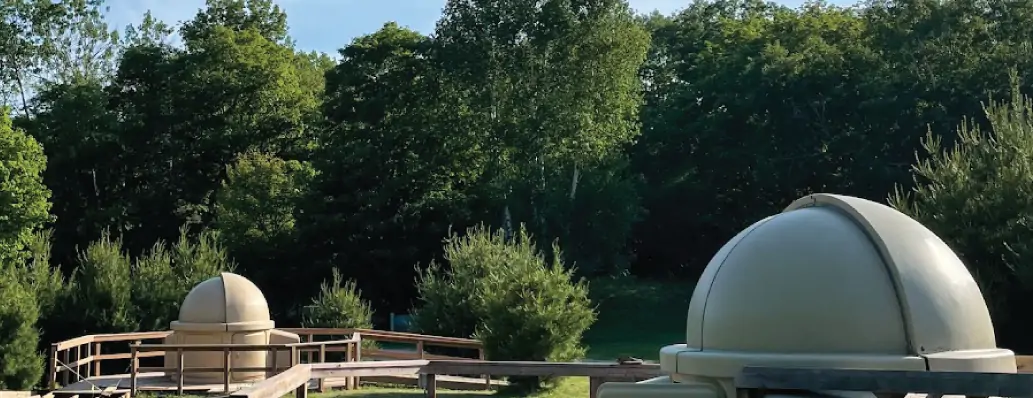
Astronomy PhD candidate Veronika Dornan served as the astronomer in residence at Killarney Provincial Park. She’ll be back again in October when the nights are longer (and bug free). Dornan has delivered dozens of talks and shows at the W.J. McCallion Planetarium and in the community. (Photos by Veronika Dornan)
BY Jay Robb, Faculty of Science
July 16, 2024
Veronika Dornan followed up the April 8 total solar eclipse with another awe-inspiring celestial moment.
This time, the astronomy PhD candidate wasn’t cheering alongside thousands of people at McMaster — she was alone with a telescope in the heart of Killarney Provincial Park just before midnight.
Dornan had the park’s telescope pointed at one of the hundreds of globular star clusters that make up the Milky Way. She was seeing light from thousands of stars that had travelled more than 10,000 years to reach the Earth.
This time there was no cheering: All she could say was a quiet “wow”.
Dornan drove five hours north to spend a week at Killarney Park as the astronomer in residence. part of an outreach program run by the park in collaboration with the Allan I. Carswell Observatory at York University.
Dornan applied because the program combines her two favourite things — astronomy and the great outdoors. While she’s a lifelong camper, hiker and canoeist, it was her first trip to Killarney.
Bruce Waters, who’s taught astronomy to the public since 1981 and co-founded Stars over Killarney, warned Dornan that once she went to the park, she wouldn’t want to go anywhere else.
The park lived up to the hype. Everywhere she looked was like a painting, something “a certain Group of Seven had already thought many times over.”
She spent her days hiking the Granite Ridge, Crack and Chikanishing trails and kayaking on George Lake. At night, she went stargazing with campers — or at least tried to. The weather didn’t cooperate most evenings — instead of looking through the park’s two domed telescopes, Dornan improvised and gave talks in the amphitheatre beneath cloudy skies.
Dornan has delivered dozens of talks over the years in McMaster’s W.J. McCallion Planetarium and out in the community, but “it’s a bit more complicated when you’re talking about the stars while at the same time fighting for your life against swarms of bugs.”
When the campers called it a night and the clouds parted, Dornan spent hours observing the stars. “I seriously messed up my sleep schedule.”
She also gave astrophotography a try during her residency, capturing images of the Ring Nebula and the Great Hercules Cluster.
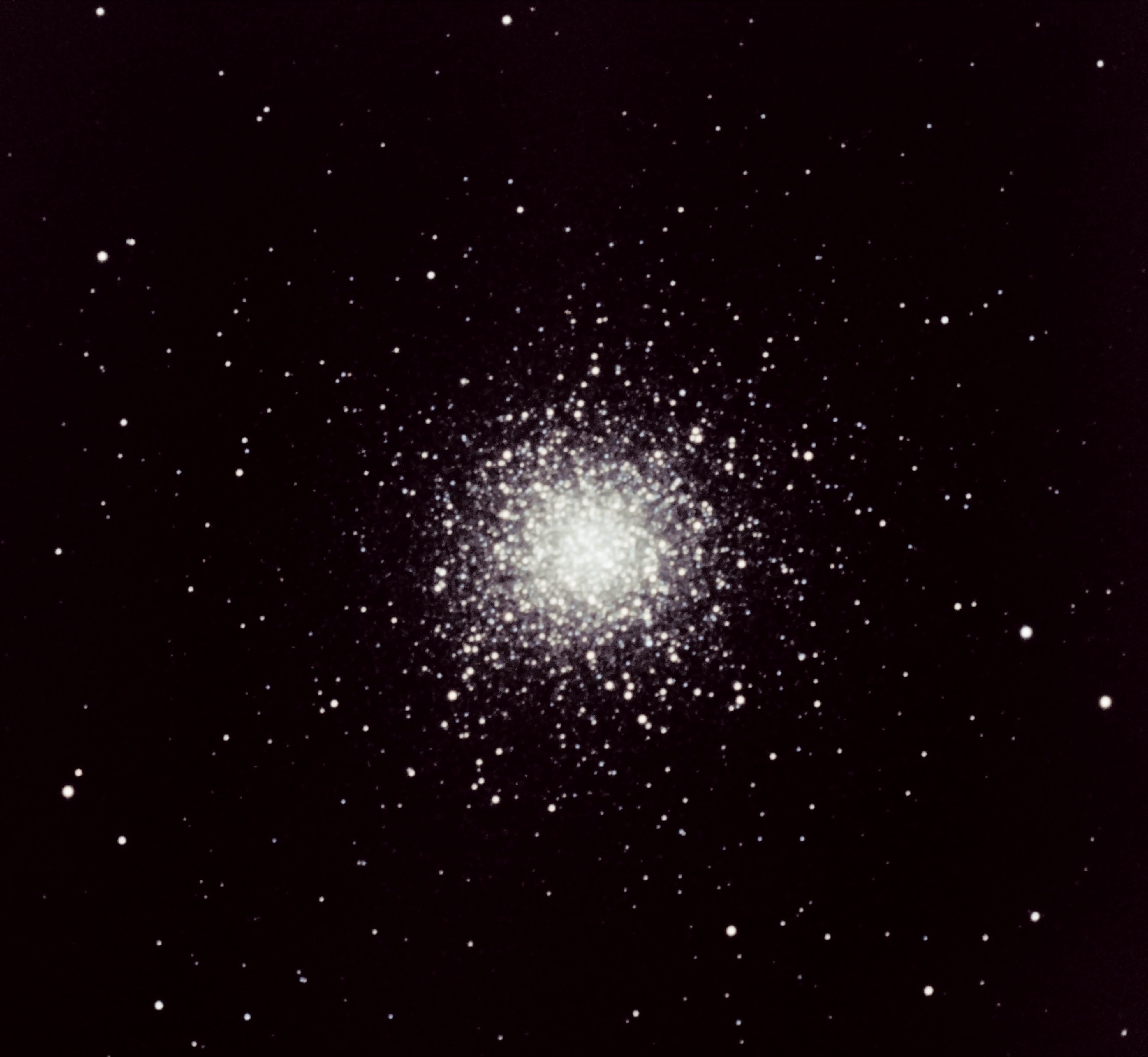
“People assume astronomers take their own photos. I needed quite a lot of guidance for how to take the images. It took a while to fiddle with the image properties, but I got my images.”
Dornan’s been invited back for another week-long residency in bug-free October, when longer nights offer more opportunities to explore and photograph the final frontier.
She’s aiming to defend her PhD thesis early next summer, then build a career that continues to combine research and outreach.
“Research leads to new discoveries which gives you exciting things to talk about. And if you’re not connecting with the public then what’s the point of doing research?”

Science
Where in Vancouver to see the ‘best meteor shower of the year’
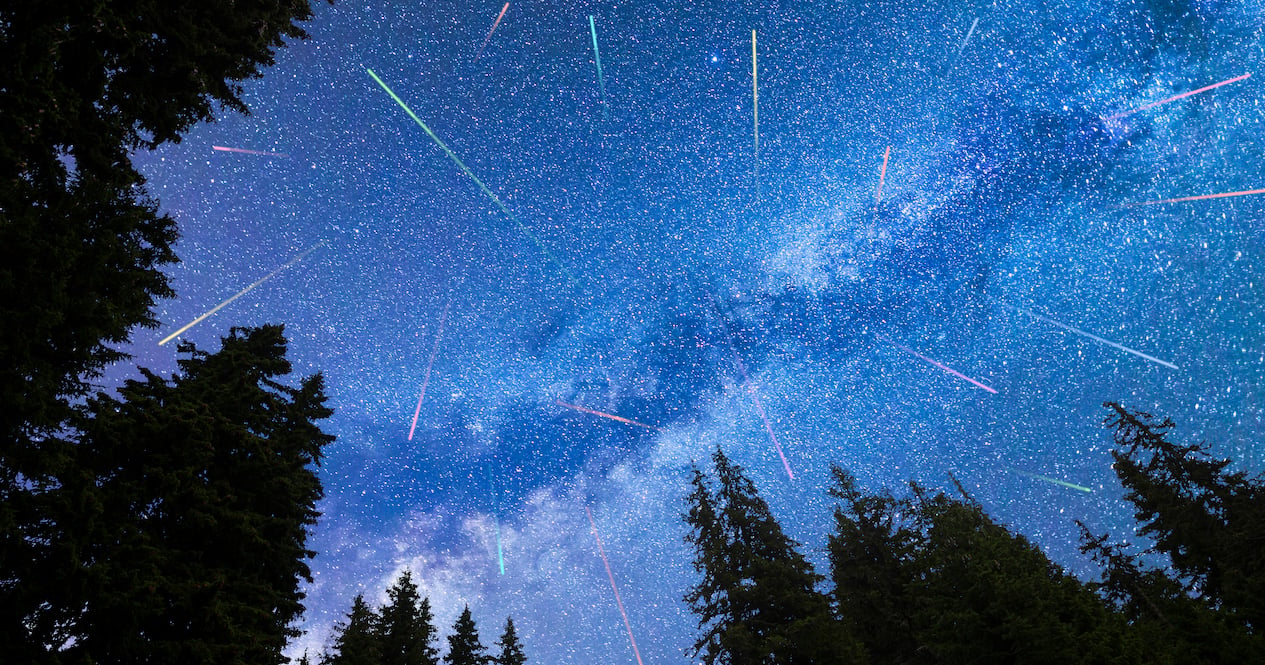
Eyes to the skies, Vancouver, because between now and September 1st, stargazers can witness the ‘best meteor shower of the year’ according to NASA.
Known for its “long wakes of light and colour,” the Perseid Meteor Shower will peak on August 12th, 2024 – so consider this list a great place to start if you’re in search of a prime stargazing spots!
Grab your lawn chairs and blankets, and seek as little light pollution as possible. Here are some ideal stargazing spots to check out in and around Vancouver this summer.
Recent Posts:
This island with clear waters has one of the prettiest towns in BC
10 beautiful lake towns to visit in BC this summer
Wreck Beach
If you’re willing to brave the stairs and the regulars, it doesn’t get much better than Wreck Beach for watching the skies – for both sunsets and stargazing. The west-facing views practically eliminate immediate distractions from the city lights.
Spanish Banks Park
Spanish Banks is the perfect mixture of convenience and quality. Its location offers unobstructed views of the skies above, and it’s far enough away from downtown to mitigate some of the light pollution.
Burnaby Mountain Park
If it’s good enough for a university observatory, it’s good enough for us. Pretty much anywhere on Burnaby Mountain will offer tremendous viewpoints, but the higher you get the better (safely).
Porteau Cove
A short drive from Vancouver gets you incredible views of the Howe Sound from directly on the water. And naturally, its distance from any nearby community makes it a prime spot for stargazing.
Cypress Mountain
In addition to having one of the best viewpoints in Vancouver period, Cypress Mountain (and the road up to it) is also a great place to watch the sky. For a double-whammy, we say that you come around sunset, then hang out while the sky gets dark. Sure, it might take a few hours, but the view is worth it.
So there you have it, stargazers! Get ready to witness a dazzling show this summer.

-

 News17 hours ago
News17 hours agoCanadaNewsMedia news August 26,2024: CN, CPKC rail service set to resume after dispute
-

 News9 hours ago
News9 hours agoB.C. caps rent increases next year at 3 per cent, matching inflation
-

 News10 hours ago
News10 hours agoPolice urge suspect in deaths of two Toronto women to surrender
-

 News10 hours ago
News10 hours agoTrudeau insists he still has what Canadians want, despite polling numbers
-

 News17 hours ago
News17 hours agoCrews face tree danger from high winds as B.C. wildfires abate due to precipitation
-

 News11 hours ago
News11 hours agoIt looked like Israel and Hezbollah had gone to war, but then they pulled back. Here’s what to know
-

 News13 hours ago
News13 hours agoSven-Goran Eriksson, Swedish soccer coach who was first foreigner to lead England team, dies at 76
-

 News21 hours ago
News21 hours agoSpieker, Fajardo lead Alouettes to 21-17 comeback win over Elks




